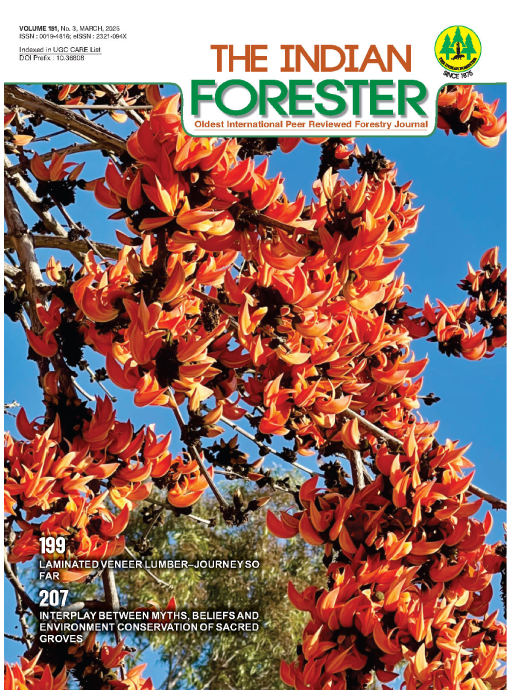Studies of Allelopathic Influence of Medicinal Plants on Important Field Crops Seeking their Sustainable Domestication in Existing Agroforestry Systems of Central Himalaya, India
DOI:
https://doi.org/10.36808/if/2025/v151i3/169806Keywords:
Allelopathy, Bioassay, Aqueous Extracts, Medicinal Plants, Field Crops, Plant Interaction.Abstract
Allelopathic effect of 2-medicinal plant species. (Aloe vera and Withania somnifera) on germination and seedling growth of 4-crops (Triticum aestivum, Brassica campestris, Pisum sativum and Vigna radiata) was evaluated. The aqueous extracts ≤ 5% concentration of Aloe vera and Withania somnifera stimulated the germination and seedling growth of some crops (Brassica campestris, Pisum sativum and Vigna radiata), but > 5% concentration caused inhibition. Aloe vera and Withania somnifera aqueous extracts significantly inhibited the germination and seedling growth of Trititcum aestivum. All test crops were affected at high concentrations of aqueous extracts (whole plant) except Brassica campestris while lower concentration stimulated the growth of Brassica campestris, Pisum sativum and Vigna radiata. The suitability of medicinal plant species, based on laboratory trials followed the order: Withania somnifera>Aloe vera and the order of agriculture field crops preference as: Vigna radiata>Pisum sativum >Brassica campestris >Triticum aestivum.References
Alipoor M., Mohsenzadeh S., Teixeira da Silva J.A. and Niakousari M. (2012). Allelopathic Potential of Aloe vera. Medicinal and Aromatic Plant Science and Biotechnology, 6(1): 78-80.
Anjum A., Hussain U., Yousaf Z., Khan F. and Umer A. (2010). Evaluation of allelopathic action of some selected medicinal plant on lettuce seeds by using sandwich method. Journal of Medicinal plant Research, 4: 536-541.
Arowosegbe S. and Afolayan A.J. (2012). Assessment of allelopathic properties of Aloe ferox Mill. on turnip, beetroot and carrot. Biological Research, 45(4): 363-368. DOI: https://doi.org/10.4067/S0716-97602012000400006
Chandra S., Chatterjee P., Dey P. and Bhattacharya S. (2012). Allelopathic effect of Ashwagandha against the germination and radicle growth of Cicer arietinum and Triticum aestivum. Pharmacognosy Research, 4(3): 166-169. DOI: https://doi.org/10.4103/0974-8490.99082
Fangue-Yapseu G.Y., Mouafo-Tchinda R.A., Fomekong Kenne M., EffaOnomo P. and Djocgoue P.F. (2021). Alelopathic Effect of Three Wild Plants (Azadirachta indica, Tithonia diversifolia and Thevetia peruviana) on Tomato (Lycopersicum esculentum Mil.) Growth and Stimulation of Metabolites Involved in Plant Resistance. American Journal of Plant Sciences, 12(3): 285-299. DOI: https://doi.org/10.4236/ajps.2021.123018
Farooqi A.A. and Sreeramu B.S. (2004). Cultivation of Medicinal and Aromatic Crops. Universities Press (India) private Limited. First print in 2001, reprinted & revised in 2004, pp-647.
Islam A.K.M.M., Yeasmin S., Qasem J.R.S., Juraimi A.S. and Anwar M.P. (2018). Allelopathy of medicinal plants: current status and future prospects in weed management. Agricultural Sciences, 9: 1569-1588. DOI: https://doi.org/10.4236/as.2018.912110
Islam A.K.M.M., Hasan M.M., Yeasmin S., Abedin M.A., Kader M.A., Rashid M.H. and Anwar M.P. (2019). Bioassay screening of tropical tree sawdust for allelopathic properties and their field performance against paddy weeds. Fundamental and Applied Agriculture, 4(3): 906- 915. DOI: https://doi.org/10.5455/faa.54326
Kato-Noguchi H. (2020). Current research status of allelopathy of plants grown in Bangladesh. Fundamental and Applied Agriculture, 5(1): 1-9. DOI: https://doi.org/10.5455/faa.73168
Kumar N., Handa A.K., Dev I., Ram A., Chand L. and Shukla A. (2018). Allelopathic Effect of Aqueous Leaf Extract of Melia dubia on Seed Germination and Growth of Zea mays. Bull. Env. Pharmacol. Life Sci., 7(12): 55-60.
Kumari N., Srivastava P., Mehta S., Moanaro and Das B. (2016). Allelopathic effects of some promising agro forestry tree species on different annual crops. Ecology, Environment and Conservation, 22(1): 225-236.
Kruse M.M. and Strandberg B. (2000). Ecological effect of Allelopathic Plants – A Review. National Environmental Research Institute – NERI Technical Report. No.315. Silkeborg, Denmark.
Nazir T., Uniyal A.K. and Todaria N.P. (2006). Allelopathic behavior of three medicinal plant species on traditional agriculture crops of Garhwal Himalaya, India. Agroforestry Syst., 69(3): 183-187. DOI: https://doi.org/10.1007/s10457-006-9023-8
Nazir T., Uniyal A.K. and Ahmed M. (2014). Allelopathic response of medicinal plants on germination and growth of traditional field crops. Indian Forester, 140(7): 695-700.
Nourimand M., Mohsenzadeh S., Teixeira da Silva J.A. and Saharkhiz M.J. (2011). Allelopathic potential of fennel (Foeniculum vulgare Mill.). Medicinal and Aromatic Plant Science and Biotechnology, 5(1): 54-57.
Rice E.L. (1984). Allelopathy, (first edit 1974 by the same editor) (Second ed.), Academic Press, Orlando, Florida, pp. 422.
Rice E.L. (1995). Biological control of weeds and plant diseases. Advances in applied allelopathy, University of Okhalahoma Press, Norman. pp. 69–72.
Rusdy M. and Ako A. (2017). Allelopathic effect of Lantana camara and Chromolaenaodorata on germination and seedling growth of Centromapubescens. International Journal of Applied Environmental Sciences, 12(10): 1769-1776.
Saharkhiz M.J., Ashiri F., Salehi M.R., Ghaemaghami J. and Mohammadi S.H. (2009). Allelopathy potential of essential oils from Carumcopticum, Cuminumcyminum, Rosmarinus Officinalis, and Zataria Multiflora Boiss. Medicinal and Aromatic Plant Science and Biotechnology, 3: 32-35.
Sharma J.R. (1998). Statistical and biometrical techniques in plant breeding. New age International publication, Pp-432.
Umer A., Yousaf Z., Khan F., Hussain U., Anjum A., Nayyab Q. and Younas A. (2010). Evaluation of allelopathic potential of some selected medicinal species. Afr. J. Biotechnol., 9: 6194-6206.
Vasishth A., Kokliyal N., Joshi R. and Dhanai C.S. (2020). Allelopathic effects of tree species on germination and seedling growth of traditional agricultural crops of Garhwal Himalayas. Indian J. of Agroforestry, 22(2): 56-61.
Yeni I.J., Dele O.S., Ademola I.J. and Adeniran A.J. (2010). Allelopathic effect of leaf extract of Azardirachta indica and Chromolaena odorata against post harvest and transit rot of tomato (Lycopersicum esculentum L). Journal of American Science, 6: 1595-1599.
Downloads
Downloads
Additional Files
Published
How to Cite
Issue
Section
License
Unless otherwise stated, copyright or similar rights in all materials presented on the site, including graphical images, are owned by Indian Forester.





